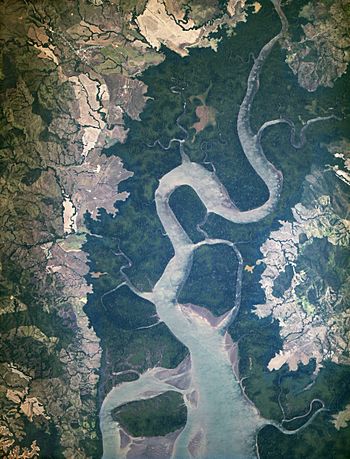San Pablo River (Panama) facts for kids
Quick facts for kids San Pablo River |
|
|---|---|

Rio San Pablo
|
|
|
Location of mouth
|
|
| Native name | Rio San Pablo (Spanish) |
| Country | Panama |
| Physical characteristics | |
| River mouth | Gulf of Montijo, Pacific Ocean 7°51′13″N 81°11′01″W / 7.853525°N 81.183529°W |
The San Pablo River is a river located in the country of Panama. It is an important natural waterway that flows into the Gulf of Montijo. This gulf is a large bay that connects to the vast Pacific Ocean.
Contents
What is the San Pablo River?
The San Pablo River is a natural stream of fresh water. It flows across the land, usually from higher ground to lower ground. Rivers like the San Pablo are vital parts of the Earth's water cycle. They collect water from rain and smaller streams.
Where is Panama?
Panama is a country in Central America. It connects North America and South America. Panama is famous for its amazing canal, the Panama Canal. This canal links the Atlantic and Pacific Oceans. Panama has a tropical climate. This means it is warm and humid all year round.
The Gulf of Montijo
The San Pablo River ends its journey in the Gulf of Montijo. A gulf is a large inlet of the sea. It is almost surrounded by land, except for a narrow opening to the ocean. The Gulf of Montijo is on Panama's Pacific coast. It is known for its rich natural environment.
Importance of the Gulf
The Gulf of Montijo is a special place. It has many mangroves and islands. Mangroves are unique trees that grow in salty coastal waters. They provide a home for many types of fish, birds, and other animals. The gulf is also important for local communities. People use it for fishing and transportation.
Why are Rivers Important?
Rivers like the San Pablo River are very important for many reasons. They provide fresh water for plants, animals, and people. Many cities and towns are built near rivers. This is because rivers offer a source of drinking water. They also help with farming and transportation.
Rivers and Nature
Rivers create diverse habitats. This means they are home to many different kinds of plants and animals. Fish, insects, birds, and mammals all depend on rivers. Rivers also help shape the land. They carry soil and rocks, creating valleys and deltas.
Rivers and People
For people, rivers have been important for thousands of years. They were used for travel and trade. Rivers also provide power. Hydroelectric dams use the force of flowing water to make electricity. This clean energy helps power homes and businesses.
See also
 In Spanish: Río San Pablo para niños
In Spanish: Río San Pablo para niños


